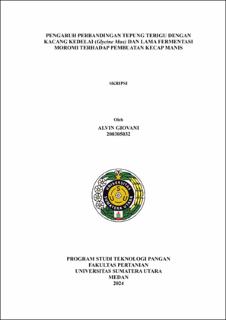Pengaruh Perbandingan Tepung Terigu dengan Kacang Kedelai (Glycine Max) dan Lama Fermentasi Moromi terhadap Pembuatan Kecap Manis
Effect of the Ratio of Wheat Flour with Soybeans (Glycine Max.) and Moromi Fermentation Time on Sweet Soy Sauce Production

Date
2024Author
Giovani, Alvin
Advisor(s)
Sinaga, Hotnida
Nurminah, Mimi
Metadata
Show full item recordAbstract
Soybeans is a high-protein legume commodity frequently processed or consumed by Indonesian society. In 2023, Indonesia imported 1.94 million tons of soybeans from the United States. The processing of soybeans into sweet soy sauce can help minimize soybean imports by substituting or adjusting raw materials. Wheat flour can provide additional nutritional sources during koji and moromi fermentation. Moromi fermentation plays a role in enhancing the quality of sweet soy sauce in terms of color, aroma, and umami flavor. The purpose of this research was to determine the effect of the ratio of wheat flour to soybeans and moromi fermentation time on sweet soy sauce while minimizing soybean usage. The research design was a Complete Randomized Factorial Design (CRFD) with two treatments: the ratio of wheat flour to soybeans (T) (0:100; 25:75; 50:50; 75:25) and moromi fermentation time (L) (1 month, 2 months, 3 months).
The results show that the ratio of wheat flour to soybeans (T) had a highly significant effect (P<0.01) on the protein content of moromi, pH of moromi, protein content of sweet soy sauce, ash content of sweet soy sauce, total flavonoids of sweet soy sauce, color test of sweet soy sauce, hedonic taste of sweet soy sauce, and overall acceptance of sweet soy sauce. The moromi fermentation time (L) also had a highly significant effect (P<0.01) on the protein content of moromi, pH of moromi, protein content of sweet soy sauce, color test of sweet soy sauce, and hedonic taste of sweet soy sauce. The best treatment was obtained based on the De Garmo method, which was treatment T2L3 with a ratio of wheat flour to soybeans (25:75) and a moromi fermentation time of 3 months.
Collections
- Undergraduate Theses [638]
